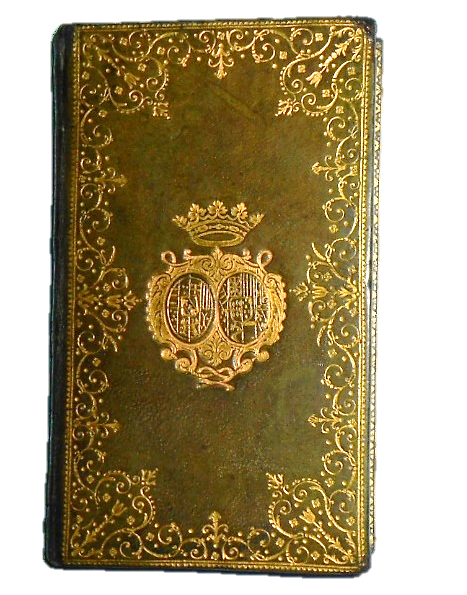Pacifique [Claude-François] Rousselet. Histoire et Description de l’église royale de Brou, élevée à Bourg-en-Bresse, sous les ordres de Marguerite d’Autriche, entre les années 1511 & 1536. Paris, Desaint et Comte, 1767. In-12. vii, [1 p. chapter table], 131 pp., [5 pp. indexes and approvals]. Contemporary green morocco, flowered flat spines, gilt title, lace decoration on the cover plates with golden arms in their center, golden fillet on cuts, golden rolls and fillet on inner covers, with pink silk, gilt edges. ( Mors and joints restored).
First edition, the work was republished in Lyon in 1788, “curious work and full of research” (Fourquet).
The author, franc-comtois born in Pesmes, in Haute-Saône in 1725, Reformed Augustine of the Royal Convent of Brou under the name of P. Pacifique, was renowned as a teacher and preacher of his order. He was one of the first members of the emulation society established in Bourg. At the abolition of religious orders, he withdrew to his family, in Besançon, where he died on 20 August 1807.
With the arms of Madame de Marsan (1720 – 1803), who was the governess of the children of France, the future Louis XVI, and his siblings, . 1754 to 1776.
Marie-Louise-Geneviève de Rohan-Soubise, great – granddaughter of Charles IV of Lorraine and Beatrix of Cusance, had married Gaston of Lorraine, Count of Marsan (1721–1743). As well as her husband, she was allied with the Habsburg-Lorraine. As our author born in the bailiwick of Gray, she was a Franc-Comtoise by her grandmother, Beatrix of Cusance (Castle of Belvoir, 1614 – Besançon, 1663), and Baroness of Belvoir, in the Doubs.
The book appears while the kingdom of France, against the power of England and Prussia, was bound with the Austrian Empire by the Treaty of Versailles signed in 1756 and comes the Duchy of Savoy. The marriage of the dolphin, future Louis XVI, with Marie-Antoinette of Austria had been decided as soon as 1766 before being celebrated in 1770 while the two brothers, Provence and Chartres, future Louis XVIII and Charles X, will marry the two sisters of Savoy, Marie-Joséphine and Marie-Thérèse in 1771 and 1773, followed by the wedding of Clotilde de France with the Duke of Savoy Charles-Emmanuel IV in 1775. This rapprochement of France with Austria was to delight Madame de Marsan, herself, as well as her late husband, being allied with the Habsburg-Lorraine. In this context, theHistoire et Description de l’église royale de Brou, exalts the houses of Habsburg and Savoy, highlighting this masterpiece of a princess in love, the very powerful Archduchess Margaret of Habsburg (1480-1530), Archduchess of Austria, Duchess of Savoy, governess of the Burgundian Netherlands, daughter of Emperor Maximilian Ist, godmother and aunt of Charles V. She built the royal church of Brou, masterpiece of Flemish flamboyant Gothic art, in Bourg-en-Bresse, then one of the capitals of Savoy, in memory of her husband the Duke of Savoy Philibert the Beautiful, dead in 1504, only 24 ., with whom she will rest at her death, without having remarried, faithful forever.
What better example of love and fidelity given by an exceptional princess of the House of Habsburg for her late husband the Duke of Savoy, could Madame de Marsan show the children of France, moreover so flattering for nobility of her house ?
This copy with her arms is all the more exceptional.
Arms : O. H. R., pl. 55, tool n° 2. Author : Michaud, Biographie universelle, t. XXXIX, p. 162 and Fourquet, Les Hommes célèbres et les Personnalités marquantes de Franche-Comté, p. 174.
Sold


